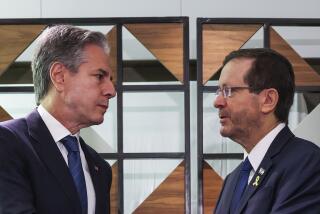U.S. Shows Flexibility in Nuclear Talks
- Share via
BEIJING — In an apparent bid to gain the initiative and blunt charges that it has been inflexible, the United States on Wednesday laid out a complex proposal at the start of a new round of talks aimed at finding a way to end North Korea’s nuclear weapons program.
The U.S. has come under criticism in Asia for refusing to compromise even as North Korea has offered olive branches to its neighbors.
“We are prepared for serious discussion and we have a proposal to offer,” U.S. Assistant Secretary of State James A. Kelly said in an opening statement at the six-party talks here, which involve the United States, the two Koreas, China, Japan and Russia.
Under the plan, North Korea would have to meet several conditions during an initial three-month period, according to a senior Bush administration official who spoke on condition of anonymity.
These include providing a full accounting of its weapons systems, granting the U.S. access to its nuclear operations, allowing monitoring, and disabling some of its more dangerous weapons.
During the same period, the energy-starved country would receive heavy fuel oil from Japan and South Korea, along with a provisional agreement that the U.S. would not attack it. Washington also would start reviewing North Korea’s longer-term energy needs and the sanctions the U.S. imposes on the Stalinist state.
Over an unspecified period, the senior official said, the U.S. would then provide a more permanent security assurance, as North Korea moved to dismantle all its plutonium- and uranium-based nuclear weapons programs. North Korea also would pledge that it would not backslide on the agreement.
A close look at the the proposal suggests that there is little new other than the specific time frame and the fact that the U.S. conditions are presented publicly in a relatively concise form.
What arguably is different is the U.S. tone. Senior U.S. officials apparently sought to present themselves Wednesday as reasonable, flexible and willing to entertain any proposal that achieves their goal of a nuclear-free Korean peninsula.
They said repeatedly that they were not hostile to North Korea, and they underscored patience and diplomacy as the means to a solution.
Analysts said the apparent change reflected concern in Japan, South Korea and China that Washington was being rigid, and possibly losing the public relations battle on North Korea.
North Korean leader Kim Jong Il recently played host to Japanese Prime Minister Junichiro Koizumi in Pyongyang, the North’s capital. He also agreed to end the decades-long propaganda war with South Korea, and he traveled to China to study economic reforms.
“I would say the Bush administration has been a bit too stubborn,” said Mei Renyi, director of the American Studies Center at Beijing Foreign Studies University. “And I think North Korea has made some pretty good concessions.”
Senior U.S. officials said Wednesday that they were dropping their use of the term CVID, or complete, verifiable, irreversible dismantlement, to describe U.S. preconditions for any deal.
“It is an acronym that seems to inflame sensibilities, so we don’t feel it’s necessary to use that term,” a senior official said. “Essentially, the U.S. side believes it’s time to make some progress.”
North Korean delegates had no immediate response to the proposal, although earlier in the day, envoy Kim Gye Gwan had repeated his country’s position: Pyongyang was willing to renounce nuclear weapons in exchange for aid and an end to Washington’s “hostile policy.”
North Korea essentially has only one card to trade -- its nuclear capability -- and it wants to ensure it obtains the best terms.
It is likely to view the U.S. plan with a jaundiced eye, analysts said. It almost certainly will want to know the exact security assurances the U.S. is willing to provide, given that its entire defense capability would be vulnerable to U.S. attack once it disclosed the locations and capabilities of its weapons.
It will probably ask for longer than the three months proposed. And it is likely to seek a highly detailed agreement on the benefits it can expect, and when. It is not clear how the two sides could hammer out the terms of an accord in between the occasional six-party talks.
Though several analysts expressed surprise that the U.S. administration had offered a proposal at all this week, some suggested that it was designed more to look reasonable than to create a real breakthrough.
“I think they’re using this opportunity to change the image that they have a very rigid foreign policy,” said Jin Linbo, Asia-Pacific studies director at the China Institute of International Studies in Beijing. “I don’t think they’re serious about this proposal, especially at this stage so close to the election.”
More to Read
Sign up for Essential California
The most important California stories and recommendations in your inbox every morning.
You may occasionally receive promotional content from the Los Angeles Times.










